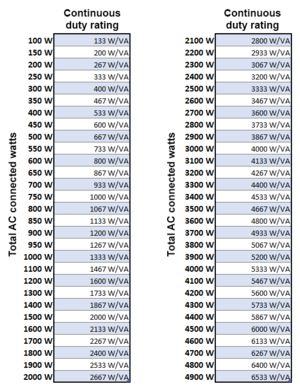Simplified inverter sizing and selection
The inverter is sized and selected almost completely based upon the power demands of the user outlined in the AC load evaluation. The size of the PV source does not affect the size of the inverter and the energy storage system is only a concern if its capacity is significantly undersized relative to the size of the inverter as all types of batteries have a maximum amount of discharge current that they can safely supply.
The basic considerations for sizing and selecting an inverter are the following:
- The input voltage must match the DC system voltage.
- The inverter should be able to meet the continuous power demand for all loads that will operate at the same time.
Assumptions:
- Loads are assumed to have an average Power factor of .75
- The system has no large surge loads.
This process is intended to serve as a guide, but the best option for a particular project will largely depend upon the available inverter sizes, the cost, and the particular project. There are a few common cases in which one may choose a different inverter size than is suggested here:
- It may make sense to buy an inverter that is smaller than is suggested by this process to keep costs low as the next size of inverter is significantly more expensive or would require the addition of an additional inverter that is stacked or added in parallel. In this case the users that they will have to manage their loads to avoid overloading the inverter. This makes the most sense with large infrequent loads that the users turn on and off. This approach is not recommended for projects that have large loads that may operate automatically - like a well pump or a refrigerator - as these loads are difficult to manage.
- It may make sense to buy an inverter that is larger than is suggested by this process to enable system expansion in the future or new additional loads.
Step 1: Determine the inverter power/continuous duty rating
All inverters have a continuous output (duty) rating that can be found in volt-amperes (VA) or watts (W) on their specifications sheet, which is the capacity that the inverter has to continuously supply loads. VA = volts × amperes, just like Power (P) in watts, but is used to account for power factor. A certain margin of Power factor is factored into the calculations in the table below, making it unnecessary to determine and calcualte for each load. Regardless of the value used by the manufacturer (VA or W), the continuous duty rating of the inverter should exceed the Total AC connected watts.
